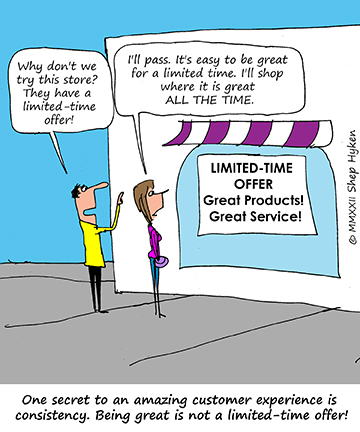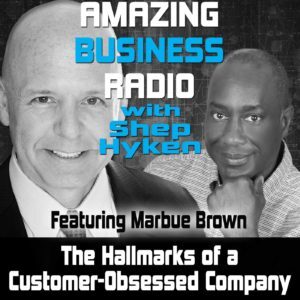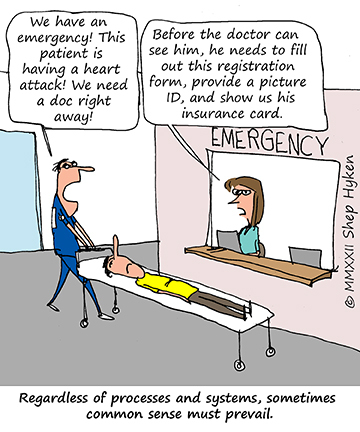Shep Hyken's Blog, page 53
November 28, 2022
5 Top Customer Service Articles of the Week 11-28-2022
Each week, I read many customer service and customer experience articles from various resources. Here are my top five picks from last week. I have added my comment about each article and would like to hear what you think too.
When CEOs Engage Directly with Customers by G. Tomas M. Hult(Harvard Business Review) Customer expectation in the United States has held steady for the last decade, while customer satisfaction has deteriorated. To reverse this trend, many companies are now strategically leveraging all parts of their organizations to offer customer-centric approaches to increase customer satisfaction. CEOs can potentially serve as important customer service reps in complementary roles to frontline customer service, sales, and customer experience management personnel. But do the potential benefits of the CEO as customer service rep outweigh the potential drawbacks?
My Comment: What is the likelihood that Bill Gates, Jeff Bezos, Elon Musk, or other high-profile CEOs would take the time to answer a question or complaint from a customer? It’s more likely than you might think. In this article by Tomas Hult, part of the team that brings you the American Customer Satisfaction Index, you will learn the importance and power of the CEO, president, or owner of a company spending time on the frontline, hearing from, learning from and answering customers questions, comments, and complaints.
3 Tips To Improve Your Survey Response Rates by Kelechi Okeke(CustomerThink) Customers are constantly evolving and their behaviours has been significantly impacted on by the COVID-19 pandemic. Now more businesses are working hard to keep a pulse on their customers to better understand their needs. In doing this, they strategically reposition their operations, product, services as well as the processes to meet those needs.
My Comment: I’m often asked, “How can I get more customers to respond to our surveys?” There are plenty of reasons customers respond to some and not others. My friend from Africa, Kelechi Okeke, has written an interesting article that answers that very question.
Brands Must ALWAYS Listen to Customers! by Debbie Laskey(Debbie Laskey’s Blog) Jeremy Watkin is Director of Customer Experience and Support at NumberBarn and cofounder of the CustomerServiceLife blog. He has more than 20 years of experience as a customer service and contact center professional leading high-performing teams. He has been recognized as a thought leader for his writing and speaking on a variety of topics including quality management, outsourcing, customer experience, contact center technology, CCaaS (Contact Center as a Service), product marketing, social media, and more.
My Comment: Of course, you listen to your customers! That’s what the title implies, but there’s more to this article than a tip on listening. The author interviewed Jeremy Watkin, Director of Customer Experience and Support at NumberBarn, who is also well known for his expert commentary in the customer service world. There are some great tips and examples throughout the interview. To paraphrase a quote from Watkin: “The moment you think you don’t need to listen to your customers, you’re headed for trouble.”
The Secret’s Out: Murphy Door Unlocks Hidden Benefits with BILT by BILT Incorporated(BILT Incorporated) Murphy Door is the industry innovator in creative door solutions. They manufacture customizable hidden bookcase doors, dresser and hamper doors, and Murphy beds that add functionality to wasted space. Founded in 2012 by firefighters seeking supplemental income and a flexible schedule, the company is customer and employee centric. CEO Jeremy Barker believes these two focal points go hand in hand: “Happy employees create happy customers. You must eliminate as much friction as possible in the customer experience.”
My Comment: A frictionless experience is not only for customers. Employees benefit as well. This article is a case study of how Murphy Door created a digital support experience using BILT, a customer service solution that delivers 3D interactive instructions and tutorials that give customers the information they need and reduces overall customer support costs.
What Is Advocacy Marketing? Let Your Customers Speak for You by Ajit Narayan(G2) Advocacy marketing is the process of turning customers into brand advocates. It’s the best way to turn word of mouth into a positive force that drives your business forward. An advocacy marketing strategy helps build mutually beneficial customer relationships with customers, promote your brand, and reach your target audience more effectively. It’s an essential component of any digital marketing strategy.
My Comment: This last article in our Top Five roundup is more about marketing than customer service or experience. But what drives this strategy is the CX. It’s about word-of-mouth marketing, which the author refers to as advocacy marketing. He shares five steps to get you started as well as how to avoid potential mistakes and pitfalls.
[image error]Shep Hyken is a customer service expert, professional speaker, and New York Times bestselling business author. Go to The Customer Focus to learn more about our customer service training programs. Follow on Twitter: @Hyken
to learn more about our customer service training programs. Follow on Twitter: @Hyken
The post 5 Top Customer Service Articles of the Week 11-28-2022 appeared first on Shep Hyken.
November 25, 2022
Guest Post: Transactional vs Relational Customer Service
This week, we feature an article by Deniz Kuran, Head of Marketing at Idiomatic, an organization that helps companies understand their customers by translating customer feedback into actionable data. She discusses the difference between transactional and relational customer service.
Effective customer service should contribute to a positive relationship between the organization and the customer. While customer service used to focus on promptly addressing individual complaints and requests, we know customers’ needs are more complex than this.
Beyond convenience, customer service should develop customers’ sense of belonging and recognition. A successful customer service experience should leave the customer feeling valued and appreciated by the organization.
What Is the Difference Between Relational and Transactional?Essentially, transactional vs. relational customer service is the difference between a one-time purchase and lifelong customer loyalty.
Transactional customer service is low-effort and short-term: it focuses on getting the issue resolved efficiently, sometimes at the expense of experience. Relational customer service aims to contribute positively to a customer’s relationship with the brand by providing a personalized experience. It satisfies the customer’s need for approaching customer service and their need for connection and appreciation.Relational customer service is more effective than transactional customer service because it centers around bringing human experience to a functional interaction. Relational customer service builds trust between a business and its customers. Customers who feel they can rely on a company are more likely to purchase again.
An advantage of relational customer service allows businesses to collect customer intelligence. This information allows for a more personalized experience for each customer.
Finally, relational customer service creates an emotional connection between a business and its patrons. Customers who feel connected to a company are more likely to remain loyal.
What Is a Transactional Customer Relationship?In a transactional customer relationship, the customer and company interact on a one-time or short-term basis. There is no ongoing relationship between the customer and the company after the transaction is complete. For example, if a customer buys a product from a company and then never interacts with the company again, that is a transactional relationship.
What Is Transactional Customer Service?Transactional customer service is the most basic form of customer service. The goal is to sell something without much customer contact and with little commitment. The focus is on turning over inventory and bringing in new customers.
What Is Relational Customer Service?Relational customer service involves an ongoing, meaningful relationship between a business and its clientele. This type of customer service focuses on building long-term relationships rather than simply completing a transaction.
Relational customer service is a more effective way to build loyalty and customer lifetime value (CLV). Studies have shown that customers who receive relational customer service are more likely to make repeat purchases. They’re also more likely to recommend the company to others.
Creating a Relational Customer Service StrategyEvery company should focus on providing superior customer service.
This means going above and beyond to meet customer needs and can include sending thank-you notes for purchases and providing immediate support when customers have questions or concerns.
All businesses should focus on developing long-term relationships with their customers. This is achieved by regularly interacting with customers and developing a personalization strategy. Personalization goes beyond including the customer’s name in messaging. Identifying their preferred communication channels is an effective way to fulfill customer needs without them having to ask. Using satisfaction ratings, session duration, and most frequently used channels, you can organize customers into preferred communication methods; phone calls, emails, chat, or video calls.
The strategy may also include sending personalized messages on holidays and birthdays.
A customer relationship management (CRM) system keeps buyer information organized and accessible. Details relating to purchase history, communication preferences, and personal information are easy to find using this software. These tools can improve the overall customer experience.
Rewarding customer loyalty shows customers that you value their patronage. You can offer loyalty points, discounts, and exclusive deals as part of your customer rewards program.
Leveraging AI in communication flows can improve efficiency, resulting in a more positive customer service experience. Chatbots can take care of simple questions and concerns, freeing up your team to handle more complex concerns.
Following these steps, businesses can create a relational customer service strategy to improve customer loyalty and increase revenue.
Creating a relational customer service strategy is essential for businesses that want to build loyalty and customer lifetime value.
Customer Lifetime Value (CLV)CLV is the total dollar amount a customer is expected to spend on a product or service over their lifetime. Businesses that focus on relational customer service are more likely to have high CLV because customers are more likely to repurchase and become brand loyal.
The Importance of Collecting Customer IntelligenceCollecting customer intelligence is essential for businesses seeking to offer a more personalized experience. This information can segment customers, create targeted marketing campaigns, and provide a better overall customer experience.
Businesses can collect this information through surveys, interviews, focus groups, and customer data.
The Importance of Creating an Emotional ConnectionCreating an emotional connection with customers is essential for businesses that want to increase customer lifetime value. Emotional connections are made when customers feel a positive association with a company. It goes beyond knowing that their business is appreciated — they have to feel it. This emotional connection comes from the language you use to communicate with them, the approach customer service agents utilize, and the recognition of their needs or struggles.
To foster meaningful relationships with your customers, you should create marketing campaigns that resonate with their values and emotions, emphasize outstanding customer service, and identify opportunities for increased shopping convenience.
Make Relational Customer Service the Cornerstone of Your Business StrategyCustomer service is an essential element of a company’s brand reputation— a notable customer experience spreads through word of mouth, for better or worse. When done well, customer service equips your organization to retain customers in the long term, increasing CLV.
Deniz Kuran is the Head of Marketing at Idiomatic. She has 10+ years of B2B & B2C marketing experience in various sectors such as SaaS, e-commerce, education, and consumer goods.
 For more articles from Shep Hyken and his guest contributors, go to customerserviceblog.com.
For more articles from Shep Hyken and his guest contributors, go to customerserviceblog.com.
Read Shep’s latest Forbes article: Six Tips To Keep Gen-Z From ‘Quiet Quitting’
The post Guest Post: Transactional vs Relational Customer Service appeared first on Shep Hyken.
November 23, 2022
Three Ways to Be Amazing
 Creating customer amazement is a foundational concept I cover in almost every one of my customer service keynote speeches. I’ve always preached that to amaze customers, we must simply be better than average all the time. While I’ve thought a lot about this over the years, lately I have been trying to make it even simpler for people to understand. To do that, you must understand the three ways you can be amazing for your customers, including your internal customers, who are the people you work with.
Creating customer amazement is a foundational concept I cover in almost every one of my customer service keynote speeches. I’ve always preached that to amaze customers, we must simply be better than average all the time. While I’ve thought a lot about this over the years, lately I have been trying to make it even simpler for people to understand. To do that, you must understand the three ways you can be amazing for your customers, including your internal customers, who are the people you work with.
Over the Top can happen once in a while, so take advantage of those opportunities when they come. Above Average and Meeting Expectations are about consistency and predictability. If you’ve been following me, you may remember that I emphasize the word always. When your customers use the word always followed by something positive that is expected, you’re operating in the all the time zone, which means your customers will often give you high ratings and sing your praises.
My point is that being amazing isn’t that hard. It’s about paying attention to details. And now I’ve made it even easier. Just do what is expected. When you consistently do what the customer expects, they will say, “They are amazing!” and “I’ll be back!”
Shep Hyken is a customer service expert, keynote speaker, and New York Times, bestselling business author. For information on The Customer Focus customer service training programs, go to www.thecustomerfocus.com. Follow on Twitter: @Hyken
customer service training programs, go to www.thecustomerfocus.com. Follow on Twitter: @Hyken
The post Three Ways to Be Amazing appeared first on Shep Hyken.
November 22, 2022
Amazing Business Radio: Marbue Brown
 The Hallmarks of a Customer-Obsessed Company
The Hallmarks of a Customer-Obsessed CompanyCreating Loyalty through Customer-Obsession
Shep Hyken interviews Marbue Brown, an accomplished customer experience executive who has worked with some of the biggest brands in the world, including JP Morgan Chase, Amazon.com, Microsoft Corporation, and Cisco Systems. He is the author of Blueprint for Customer Obsession. He shares what differentiates customer-obsessed companies from the rest and the amazing business results that come with it.






 Top Takeaways:There is a distinction between customer-obsessed companies and others. Customer-obsessed companies go to extremes and may do counterintuitive things from the perspective of their customer-focused peers. For example:Costco is known for its extreme return policy that exceeds what other companies in the industry are willing to do. As a result, customers have total confidence that if they buy something from Costco and encounter an issue with the product, they can return it. Costco has over 100 million paid memberships, and its renewal rates are over 90%.Amazon does not take negative reviews down. They leave it up so the customer can make the decision that is right for them.Zappos has the largest selection of shoes, but if they don’t have the pair you are looking for, they will direct you to competitor websites to help you find them. As a result, 75% of Zappos sales come from existing customers, and 40% of their new customers come from recommendations.Customer-obsession creates customer preference. Customer obsessed companies’ customers are not just casual customers. They think of these companies and brands first.Customer-obsessed companies have deeply ingrained, pervasive cultures. Their customer service principles are non-negotiable and lived throughout the entire organization.And, does every employee that works at Amazon know the 16 Amazon Leadership Principles? Tune in to find out!Quotes:
Top Takeaways:There is a distinction between customer-obsessed companies and others. Customer-obsessed companies go to extremes and may do counterintuitive things from the perspective of their customer-focused peers. For example:Costco is known for its extreme return policy that exceeds what other companies in the industry are willing to do. As a result, customers have total confidence that if they buy something from Costco and encounter an issue with the product, they can return it. Costco has over 100 million paid memberships, and its renewal rates are over 90%.Amazon does not take negative reviews down. They leave it up so the customer can make the decision that is right for them.Zappos has the largest selection of shoes, but if they don’t have the pair you are looking for, they will direct you to competitor websites to help you find them. As a result, 75% of Zappos sales come from existing customers, and 40% of their new customers come from recommendations.Customer-obsession creates customer preference. Customer obsessed companies’ customers are not just casual customers. They think of these companies and brands first.Customer-obsessed companies have deeply ingrained, pervasive cultures. Their customer service principles are non-negotiable and lived throughout the entire organization.And, does every employee that works at Amazon know the 16 Amazon Leadership Principles? Tune in to find out!Quotes:“Customer-obsessed companies know how to give customers what they want before they know they need it. They understand what the inherent needs of the customers are even when they don’t articulate it.”
“Customer-obsession turns your customers from casual consumers into rabid fans. And because it does, it generates extraordinary business results.”
“I challenge companies to adopt customer-obsession as a business strategy. Companies that are customer-obsessed outperform the market by 3 or 4 times.”
About:Marbue Brown is a customer experience executive, sought-after keynote speaker, and author on CX, business strategy, and economic policy. His latest book, Blueprint for Customer Obsession, is available now on Amazon.
Shep Hyken is a customer service and experience expert, New York Times bestselling author, award-winning keynote speaker, and host of Amazing Business Radio.
This episode of Amazing Business Radio with Shep Hyken answers the following questions and more:
What does it mean to be customer-obsessed?What is the difference between a customer-obsessed company from a customer-focused company?How do you create a customer-obsessed culture?What is personalized customer service? Can you create personalization with automation?The post Amazing Business Radio: Marbue Brown appeared first on Shep Hyken.
November 21, 2022
5 Top Customer Service Articles of the Week 11-21-2022
Each week, I read many customer service and customer experience articles from various resources. Here are my top five picks from last week. I have added my comment about each article and would like to hear what you think too.
8 Big Pain Points in the Online Shopping Experience by Frank Kouretas and Jean-Walter Guillery(Retail Customer Experience) Consumers today are looking for increasing convenience and a frictionless experience. As a result, their pain points are varied and are constantly changing. All driven by advances in technology, evolving shopping experiences online, and growing expectations around speed, convenience, and delivery. Even the circumstances of their purchase now affect what frustrates them.
My Comment: Today’s customers want an easy and convenient experience. Our customer service research finds that convenience is even more important than friendly service. (So imagine if you had both!) One reason the online shopping experience is appealing to so many customers is convenience. This article includes some excellent tips for online (and traditional) retailers.
Points Are Just the Starting Point: What Loyalty Means Today by Stephanie Meltzer-Paul(Mastercard) The relationship between consumers and brands has never been as deep — or as complicated — as it is today. The shift to digital has fundamentally changed the conversation around brand loyalty from both sides of the equation.
My Comment: Loyalty programs are typically about points and perks. Spend more, you get more. However, today’s customers want more than that. They want the points and perks, but now they also want the experience. The combination of a good “points” program mixed with great service is a combination that is hard to beat.
Does a Company’s Social Purpose Impact Its Customer Loyalty? by Serena Haththotuwa(Business Leader) For decades the Net Promoter Score (NPS) has been a recognised metric of customer loyalty and a credible predictor of business growth and success. Most commonly used to benchmark the overall perception of your brand, organisations looking to increase NPS might traditionally focus on anything from new snazzy product features, through to the helpfulness of aftersales staff. There is, however, another approach that can help organisations increase NPS scores: social impact.
My Comment: 45% of consumers surveyed in our 2022 Achieving Customer Amazement study believe it’s important for a company or brand to have a cause that’s important to them. A commitment to the community and/or a social cause is more important than ever. It gets the company better ratings and reviews, not to mention repeat business.
5 Tips from Practitioners to Improve Government Customer Experience by Frank Konkel(Nextgov) An Office of Management and Budget official on Tuesday reiterated the importance of improving the federal government’s customer experience almost a year after President Joe Biden issued an executive order on the matter. “The American public should get a simple, seamless and secure customer experience when they interact with the government,” said Andy Lewandowski, digital experience advisor to the federal chief information officer within OMB. Speaking at ACT-IAC’s Customer Experience Summit, Lewandowski said customer experience is one of four key priorities for the office of the federal chief information officer, along with cybersecurity, IT modernization and using data as a strategic asset.
My Comment: It’s been a year since President Biden signed off on an executive order focused on improving the customer experience. Is the government giving good customer service? Yes! And the ideas and tips mentioned in this article apply to many other businesses outside of government.
Should You Break Up with Some of Your Customers? by Joseph A. Michelli(CEOWORLD Magazine) Breaking up with customers evokes fear for many leaders but in the words of entrepreneur and author Tim Ferriss, “What we fear doing most is usually what we most need to do.”
My Comment: Customers have options. If they don’t like a company or brand, they leave and do business elsewhere. But what if the company doesn’t like the customer? In spite of trying to build market share and acquire customers, according to Gartner’s report, Customer Service Leaders in 2022 and Beyond, by 2025, 75% of companies will “break up” with poorly fit customers. Companies are determining if certain customers are worth doing business with.
[image error]Shep Hyken is a customer service expert, professional speaker, and New York Times bestselling business author. Go to The Customer Focus to learn more about our customer service training programs. Follow on Twitter: @Hyken
to learn more about our customer service training programs. Follow on Twitter: @Hyken
The post 5 Top Customer Service Articles of the Week 11-21-2022 appeared first on Shep Hyken.
November 18, 2022
Guest Post: Why B2B Business Needs Dedicated Customer Support
This week, we feature an article by Kateryna Boiko, Marketing Director at Mobilunity, an organization that provides dedicated digital marketing and development teams to companies worldwide. She shares the benefits of having dedicated customer support in B2B organizations.
Any company needs to become a part of B2B or “business-to-business,” where legal entities establish trading relationships with each other. The purpose of such relationships is to produce goods by one business, but not for a private person, but for another business. The goods themselves can be anything, including software – websites, programs, bots, and many other stuff. This greatly improves the work of the company and brings positive results.
For example, a company needs a convenient application that allows customers to get acquainted with its products and services quickly and efficiently. In the case of such a need, the best option is to turn to another company that can provide customer support software. Companies set the price for this service as well as deadlines, and when the work is completed, the client receives a quality and client-centric product that is ready for use.
Benefits of dedicated customer supportB2B relationships have a number of advantages that set them apart from other trading relationships between companies. First and foremost are the improvements in sales. For example, if a client orders a website, they ask for dedicated customer support from a service provider to implement their project. As a result, they will get not just a platform for sales but also an “employee” ready to work 24/7 without vacations or sick leave. The site can take orders all the time, thereby increasing the company’s profits.
No less important is the fact that the product will be completely unique and client-centric. The very same site visitors will be easy to move between categories of the site and product cards and make orders. This will increase the attendance of the resource and the sales themselves, distinguishing the company from other competitors. The product created by agile development teams also greatly facilitates the work of the customer support manager, thereby allowing the company’s employees to be more comfortable. This will also increase the efficiency of ordinary employees because then it will be easier to distribute the workload during the day and finish tasks on time.
The main challenge of b2b companiesOf course, in the work of dedicated customer service, there can also be difficulties, such as the right choice of technology to be used. Sometimes the contractor may simply not understand the area in which they have to work. This greatly reduces the quality of the final product and delays the delivery of the project, so it is very important to carefully read the profile of the contractor before one starts working with them directly. In addition, it is important to pay attention to those companies that have extensive experience because they can also ensure the cybersecurity of user data. Additionally, one can consider the characteristics of the global market and the location in which the service provider operates because, depending on the country, prices for work can vary significantly.
B2B customer service best practicesB2B is very client-centric and always considers the interests and requirements of clients in order to achieve the most productive result of mutual work. This allows to the creation of a quality product that satisfies the customer and fits their needs. In addition, the purpose of such cooperation is not only to obtain a finished product but also to train the client to work productively. It is ensured by the fact that the service customer services company does not perform a raw task but also tries to get to know the client, their goals, and preferences better, which is an important part of the joint work. This type of cooperation is quite different from the standard client-executor relationship. It is a team effort to achieve a specific goal and implement an effective product that will be financially attractive to all.
More reasons why b2b business needs dedicated customer supportLast but not least, the finished product is completely unique and not like the products of competitors. The customer support partner takes the customer’s requirements into account and creates exactly what is required of them. The customer receives a completely unique product that is created for the client’s needs and purposes. The uniqueness of the site or application is also affected by the fact that the whole team of specialists is working on it. They all have experience in creating such resources and understand the client’s needs, and can implement the project in the best possible way.
Kateryna Boiko is a Marketing Director at Mobilunity.She has worked with diverse industries and markets and is now keen on sharing unique cases with the world and coaching on topics relevant to Web Analytics and Search Engine Optimization.
 For more articles from Shep Hyken and his guest contributors, go to customerserviceblog.com.
For more articles from Shep Hyken and his guest contributors, go to customerserviceblog.com.
Read Shep’s latest Forbes article: Seven Ways To Create Brand Recognition From Benihana
The post Guest Post: Why B2B Business Needs Dedicated Customer Support appeared first on Shep Hyken.
November 16, 2022
Don’t Let a Process Get In the Way of Making Smart – Even Common Sense – Decisions
 Here is another customer service horror story about a woman who was so fixated on a process that it almost cost her “customer” his life.
Here is another customer service horror story about a woman who was so fixated on a process that it almost cost her “customer” his life.
My friend Jerry went to the emergency room of his local hospital. He was in excruciating pain. Something in his abdominal area was not right. He truly felt like he was going to die.
Doubled over in pain, he limped through the waiting room to the registration desk and begged to see a doctor. The woman behind the desk said, “I’m sorry you’re not feeling well. There are two people in front of you, and you’ll have to wait your turn to register. If you sign in with your name, I’ll call you when we’re ready to get your information.”
He said, “I think I’m dying! I’m not going to make it.” After several minutes of pleading, she eventually gave Jerry the attention he deserved. Something was seriously wrong. Well, good news and bad news for Jerry. The bad news is that his appendix had burst and he needed immediate medical attention. The good news is that, even though it was serious, it is a fairly routine surgery. And during surgery, the doctor discovered he also had a hernia. (Ouch!) Today he’s doing just fine.
The process in the ER was for patients to put their names on a list – not to see a doctor, but to register to see a doctor. After waiting their turn to register, the patient would then wait again before being taken back to the examination room. However, that’s supposed to change when there is a true emergency. Somehow, the woman working reception was more interested in the process than the person. She didn’t recognize or acknowledge Jerry’s pain. Her lack of common sense judgment could have cost Jerry his life.
Managing the reception and registration process in a hospital is tricky. People come in with pains and sicknesses that, while uncomfortable, aren’t life-threatening. Then there are patients with more severe issues, such as a heart attack. The people on the front line assess the situation and determine if the patient goes straight back to see a doctor or gets sent to the reception area to wait their turn.
The point is this. It doesn’t matter the type of business you are in, regardless of processes and systems, sometimes common sense must prevail. If we hire qualified people and properly train them to do their jobs, we should let them do what they were hired to do. Give them permission to say “Yes,” teach them when they must say “No,” and coach them on finding alternatives to avoid saying “No.” Empower them to make good common-sense decisions because, in many situations, common sense prevails!
Shep Hyken is a customer service expert, keynote speaker, and New York Times, bestselling business author. For information on The Customer Focus customer service training programs, go to www.thecustomerfocus.com. Follow on Twitter: @Hyken
customer service training programs, go to www.thecustomerfocus.com. Follow on Twitter: @Hyken
The post Don’t Let a Process Get In the Way of Making Smart – Even Common Sense – Decisions appeared first on Shep Hyken.
November 15, 2022
Amazing Business Radio: Tony Sternberg
 Creating a Good Customer
Offboarding
Experience
Creating a Good Customer
Offboarding
Experience How Companies Can Provide Outstanding CX From Sign-Up to Cancellation
Shep Hyken interviews Tony Sternberg, CEO and co-founder at ProsperStack, a platform that helps companies reduce customer churn and increase their lifetime value. He shares how companies can differentiate themselves by providing an excellent customer experience from the beginning to the end of their journey.






 Top Takeaways: Companies put a lot of focus into their onboarding process, but the end of the customer’s lifecycle tends to get ignored. What looks like the end is actually a point where you can provide a great experience that retains the customers. We are in a digital world, and there are plenty of automated opportunities to make customers feel they are personally taken care of. Differentiate yourself from others by utilizing your data to create automated yet scalable experiences for your customers that still have a personalized touch. Big companies like Netflix and Amazon have the resources to provide a world-class automated experience for their customers. The challenge of small to midsize companies is that they do not have the resources to create that same level of automated process on their own. Data points, such as how long customers have been doing business with you or how frequently they use your services, determine whether customers will be long-term subscribers/customers or are ready to unsubscribe or churn. These data points can be leveraged to escalate offers or provide incentives to keep them as paying customers. Customers disproportionately judge their experiences based on how they felt at the peak (whether this is the most positive or negative experience) and at the end of their experience. The best companies can track their customers’ cadence to determine whether they’re making the most use of your products and services. Using this information correctly can help keep the customer coming back again and again. No matter what, end strong and positive. The customer doesn’t have to be right but lets them be wrong with dignity and respect. Quotes:
Top Takeaways: Companies put a lot of focus into their onboarding process, but the end of the customer’s lifecycle tends to get ignored. What looks like the end is actually a point where you can provide a great experience that retains the customers. We are in a digital world, and there are plenty of automated opportunities to make customers feel they are personally taken care of. Differentiate yourself from others by utilizing your data to create automated yet scalable experiences for your customers that still have a personalized touch. Big companies like Netflix and Amazon have the resources to provide a world-class automated experience for their customers. The challenge of small to midsize companies is that they do not have the resources to create that same level of automated process on their own. Data points, such as how long customers have been doing business with you or how frequently they use your services, determine whether customers will be long-term subscribers/customers or are ready to unsubscribe or churn. These data points can be leveraged to escalate offers or provide incentives to keep them as paying customers. Customers disproportionately judge their experiences based on how they felt at the peak (whether this is the most positive or negative experience) and at the end of their experience. The best companies can track their customers’ cadence to determine whether they’re making the most use of your products and services. Using this information correctly can help keep the customer coming back again and again. No matter what, end strong and positive. The customer doesn’t have to be right but lets them be wrong with dignity and respect. Quotes: “Customers remember the end of their experience with a company to a higher degree. If you leave a bad taste in their mouth, you not only negatively impact the customer’s experience, but also impact what that customer tells their friends and their network.”
“If customers can sign up seamlessly online, they should be able to cancel in a manner that is just as easy.”
“Customer needs change. Their ability to pay can change. Offering alternatives and a great experience when that happens is something that every business model should welcome.”
“It is easy for everyone to catch up when it comes to product features and technology. The only way to truly differentiate yourself is with the way you treat your customers.”
About:Tony Sternberg is the CEO and co-founder at ProsperStack, a platform that helps subscription businesses optimize their customer cancellation experience through automation. Prior to ProsperStack, Tony was President at CATS Software, playing key customer-facing, product, and operations roles.
Shep Hyken is a customer service and experience expert, New York Times bestselling author, award-winning keynote speaker, and host of Amazing Business Radio.
This episode of Amazing Business Radio with Shep Hyken answers the following questions and more:
Why is offboarding process important? How do you properly offboard customers? How do you differentiate yourself from your competitors?What does the peak-end rule mean? How do you add personalization to automated processes?The post Amazing Business Radio: Tony Sternberg appeared first on Shep Hyken.
November 14, 2022
5 Top Customer Service Articles of the Week 11-14-2022
Each week, I read many customer service and customer experience articles from various resources. Here are my top five picks from last week. I have added my comment about each article and would like to hear what you think too.
Partnering in Complex Times: Turning to the Experts for Best-In-Class Customer Experience by Harvard Business Review(Harvard Business Review) Years ago, in the legacy, on-premises world of siloed call centers, in-house CX management was much simpler. It was fairly one-dimensional, easily addressed with physical phone banks and basic staff management processes. The same was even true with the introduction of email as a channel. The introduction of digital channels, however, exposed the inflexibility of these premises-based systems. Their lack of flexibility paved the way for new, more dynamic cloud-based.
My Comment: This really isn’t an article. It’s a robust white paper published by Harvard Business Review, focusing on partnering with the best experts (vendors) in the customer experience (CX) world. If you find the right vendor, one who is focused on you and your organization’s success, you’ll quickly realize that it’s more of a partnership. Spend some time diving into this white paper, and you’ll appreciate the extra effort you might make to find the perfect partner to help you succeed
Top 14 Tips for Connecting with Customers from CMOs by Sarah Franklin(Salesforce) CMOs are saying “so long” to long-standing marketing playbooks. See how they’re shaking things up in this digital-first world. Join Salesforce President and CMO Sarah Franklin as she chats with digital leaders about how to create more powerful connections with your customers.
My Comment: Our first entry into this week’s Top Five wasn’t really an article but a white paper. Our second entry isn’t an article, either. It’s a video. 14 CMOs, business executives, and owners share their best tips for connecting with customers on Salesforce Plus, a show hosted by Sarah Franklin. There are plenty of good ideas, from sophisticated to simple and even emotional. Something for everyone.
Small Businesses Face Economic Strain Even With Loyal Patrons by Elizabeth Renter(NerdWallet) The relationship between a small business and its customers is unique — rarely is it purely transactional. In fact, 37% of Americans say they purchase from small businesses to receive a more personal experience. Also, 30% of them are willing to pay more and 30% are willing to wait longer at small businesses versus major retailers or chain stores, according to a new NerdWallet survey of over 3,000 U.S. adults conducted online by The Harris Poll from Oct. 3-5, 2022.
My Comment: If you’re running a small business, then this article is for you. (Even if you’re in a big company, I bet there is something you’ll learn from these ideas and strategies.) Loyalty and repeat customers are up for grabs. Companies are struggling, and if they don’t manage the problems well, customers notice. While loyal customers may be slower to leave, with enough issues, they will move on. This article explains the pain some businesses are experiencing and how to overcome it.
Why Reducing Customer Effort Leads To Loyalty by Dan Gingiss(Dan Gingiss) You can’t expect your customers to know everything. Yes, today’s customers are more connected and have access to more information than any other generation of customers in history, but they still can’t read minds (at least not yet). So why do many companies create situations where customers need to figure things out for themselves?
My Comment: I’m a big fan of reducing customer effort and eliminating friction. So much so that I wrote a book, The Convenience Revolution. In this article, fellow customer experience expert Dan Gingiss gives us his take on this powerful strategy. Don’t make customers do extra work. Reach out to customers about problems before they reach out to you. If you have “known errors,” problems you know happen routinely, fix them or find ways to mitigate them. Dan sprinkles some great stories in with these topics.
Why There’s Much More to Loyalty Schemes Than Just Bribing Customers by Hannah Bowler(The Drum) Loyalty schemes can’t just be transactional to win customers over – the best programs need to “integrate the entire customer experience,” say some of the marketers behind the most successful schemes. Brand loyalty is having a resurgence, with legacy brands such as McDonald’s opening its very first rewards club, established schemes from Costa Coffee Club and Waitrose being overhauled, and even community-based programs from Sweaty Betty and Gymshark starting up.
My Comment: Most loyalty programs are really marketing programs. They are created to get customers back, but they don’t necessarily create loyalty. However, they do create repeat business. There’s nothing wrong with that. In fact, I applaud the successful programs that get customers to come back again and again. But true loyalty programs go beyond being transactional. This article perfectly describes what a company or brand needs to do if they want true loyalty, which is to “integrate the entire customer experience” into the program.
[image error]Shep Hyken is a customer service expert, professional speaker, and New York Times bestselling business author. Go to The Customer Focus to learn more about our customer service training programs. Follow on Twitter: @Hyken
to learn more about our customer service training programs. Follow on Twitter: @Hyken
The post 5 Top Customer Service Articles of the Week 11-14-2022 appeared first on Shep Hyken.
November 11, 2022
Guest Post: Elevate Your Business’ Customer Service With the Help of QR Codes
This week, we feature an article by Claron Kinny, SEO Outreach Specialist at Beaconstac, a company that creates and manages QR codes for brands for an immersive offline and online CX. He shares how companies can use QR codes to improve customer service and experience.
We have all encountered QR codes at some point in our lives, and their popularity has only grown throughout the coronavirus outbreak. Even before the pandemic, usage of QR codes increased by 96% between 2018 and 2020, highlighting its importance in this digital era. QR codes are commonly used for payments and advertisements and are effortlessly offering a contactless solution to customers. So if you’re looking to explore QR codes for your brand, we have got you covered.
The truth is QR codes are used for numerous purposes. For instance, QR codes can effectively be implemented in customer service. They save critical data, allowing consumers to access information and execute certain activities more quickly, ensuring an excellent customer service experience.
In this blog post, we will look at some of the most creative ways companies employ QR codes to help customers and provide a matchless customer experience. Continue reading to learn more.
QR codes in customer service: How effective is it?Most websites have a customer service section, usually in the form of a chat for quick responses to simple queries. According to studies, customers now demand a near-instant response from customer service, with 90% expecting an immediate answer. So it is important to have prompt customer service in place for maximum customer satisfaction.
QR codes simplify the process of reaching out to customer service without having them figure out a way on their own to reach out to you. You can easily use QR codes to drive customers to customer assistance sections on your website, social media channels, and other platforms.
Ensuring that every time a consumer contacts your customer service, they receive timely, useful information they require is critical here. You can connect the QR codes with the live chat software on your official website so that your customers can directly land there for any queries they may have. Furthermore, they increase the speed at which customers provide feedback or look for solutions and reduce the time for resolutions as well.
How are businesses leveraging QR codes for customer service?Let us see how businesses are leveraging QR codes to provide customers with an unparalleled service experience:
QR codes for drive-thru transactionsMcDonald’s approach to consumers at its drive-thru windows is one such example. Rather than having a person take orders from vehicles, consumers may simply scan the QR code on the menu board and place their order. The order is then dispatched to the kitchen and is ready when they arrive at the window.
QR codes in hotel check-ins and roomsQR codes are used in the hospitality industry, especially by hotel chains, to interact with customers. QR codes are available at each check-in counter and on the room doors as well. Customers can find out about places to visit in the city, the in-room dining menu, and other important information needed by scanning the QR code. It may also include contact information for several departments within the building.
QR codes in storefrontsFood brands such as Dunkin Donuts use QR codes for discounts and offers. Customers need to scan the code via their smartphone camera to see all special and ongoing deals, such as “Buy-1-coffee-get-1-free”.
QR codes for product exchange and return servicesAmazon, the leading online retail giant, provides a contactless return service through QR codes. To return an Amazon product, go to a drop-off site, such as Amazon Hub Counter, Kohl’s, or UPS, and scan your QR code. This method does not need you to package or label your things. Instead, the drop-off site will be packing it, labeling it, as well as shipping your return, and that too without any charge.
QR codes for product manualsInstead of having a printed product manual, tech-savvy companies and manufacturers offer a QR code that leads to online product manuals, including troubleshooting and how-to videos, color images, and other relevant information. You can even use QR codes to redirect customers to their product’s warranty cards.
QR codes for customer feedbackIt is important for both product and service-based companies to collect feedback from their customers to plan for improvements in the future and to provide accurate assistance. Customers can scan the QR codes to submit feedback, file a complaint, or even be redirected to a customer service portal for queries. You can even create a digital business card with a QR code that you can hand out to customers. These digital business cards will have all the information you want your customers to have.
By channeling QR codes’ strength, businesses can support and connect with their customers more efficiently. QR codes play a huge role in customer services; businesses can quickly respond to every customer query, feedback, and complaint.
To sum it upIf you’re new to the world of QR codes and planning to incorporate them into your business card, websites, or social media channels, there are many QR code generators out there that come with several unique and specific features. QR codes boost the overall customer experience when used as a part of your customer service strategies. Whatever the purpose is, QR codes are an effective digital tool that gives you actionable insights into their usage, which can prove beneficial to your business.
Claron Kinny is a brand nut. He has an unceasing curiosity about what brands do to break through the clutter to stay relevant to their audience. He also loves to explore how simple tech (QR Codes lately) can be used to improve customer experiences and, consequently, scale up brands.
 For more articles from Shep Hyken and his guest contributors, go to customerserviceblog.com.
For more articles from Shep Hyken and his guest contributors, go to customerserviceblog.com.
Read Shep’s latest Forbes article: Former VP Of Amazon Preaches A Frictionless Experience
The post Guest Post: Elevate Your Business’ Customer Service With the Help of QR Codes appeared first on Shep Hyken.



